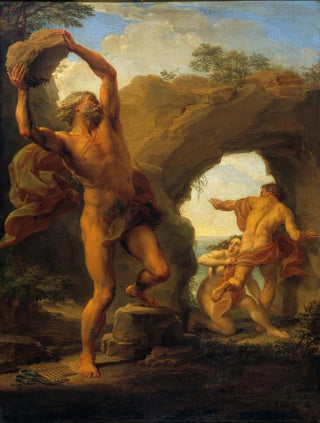Art print | Attis and Galatea - Pompeo Batoni


View from behind

Frame (optional)
The artwork "Attis and Galatea" by Pompeo Batoni stands as a true masterpiece of 18th-century painting. This canvas, depicting a mythological scene, transports viewers into a universe where love and tragedy intertwine. At the heart of this composition, the figures of Attis and Galatea, imbued with delicacy and emotional intensity, capture the very essence of human passions. The light, skillfully orchestrated by Batoni, reveals the subtleties of expressions and gestures, giving the entire piece a tender yet melancholic atmosphere. This work, with its refined aesthetic, invites deep contemplation and reflection on universal themes of love and loss.
Style and uniqueness of the work
Batoni's style is characterized by an exceptional mastery of color and light, which give his works an almost tangible dimension. In "Attis and Galatea," soft hues and delicate nuances create a visual harmony that immediately draws the eye. The composition, carefully balanced, highlights the protagonists within a natural setting, where greenery and architectural elements enrich the narrative. The drapery of the clothing, painted with remarkable precision, testifies to the artist's talent for rendering texture and movement. This stylistic singularity, combined with poignant mythological storytelling, makes this piece a perfect example of Rococo art, where elegance and sensitivity meet.
The artist and his influence
Pompeo Batoni, born in Lucca in 1708, is one of the most emblematic artists of his era. His career, marked by international success, allowed him to mingle with the greatest figures of his time. Influenced by Baroque and Neoclassical masters, Batoni developed a style that is uniquely his own, blending tradition and innovation. His approach to mythology, as exemplified by "Attis and Galatea," reveals a particular sensitivity to human emotions, a characteristic that sets him apart in the artistic landscape of his time. His influence extends well beyond his period,

Matte finish

View from behind

Frame (optional)
The artwork "Attis and Galatea" by Pompeo Batoni stands as a true masterpiece of 18th-century painting. This canvas, depicting a mythological scene, transports viewers into a universe where love and tragedy intertwine. At the heart of this composition, the figures of Attis and Galatea, imbued with delicacy and emotional intensity, capture the very essence of human passions. The light, skillfully orchestrated by Batoni, reveals the subtleties of expressions and gestures, giving the entire piece a tender yet melancholic atmosphere. This work, with its refined aesthetic, invites deep contemplation and reflection on universal themes of love and loss.
Style and uniqueness of the work
Batoni's style is characterized by an exceptional mastery of color and light, which give his works an almost tangible dimension. In "Attis and Galatea," soft hues and delicate nuances create a visual harmony that immediately draws the eye. The composition, carefully balanced, highlights the protagonists within a natural setting, where greenery and architectural elements enrich the narrative. The drapery of the clothing, painted with remarkable precision, testifies to the artist's talent for rendering texture and movement. This stylistic singularity, combined with poignant mythological storytelling, makes this piece a perfect example of Rococo art, where elegance and sensitivity meet.
The artist and his influence
Pompeo Batoni, born in Lucca in 1708, is one of the most emblematic artists of his era. His career, marked by international success, allowed him to mingle with the greatest figures of his time. Influenced by Baroque and Neoclassical masters, Batoni developed a style that is uniquely his own, blending tradition and innovation. His approach to mythology, as exemplified by "Attis and Galatea," reveals a particular sensitivity to human emotions, a characteristic that sets him apart in the artistic landscape of his time. His influence extends well beyond his period,






